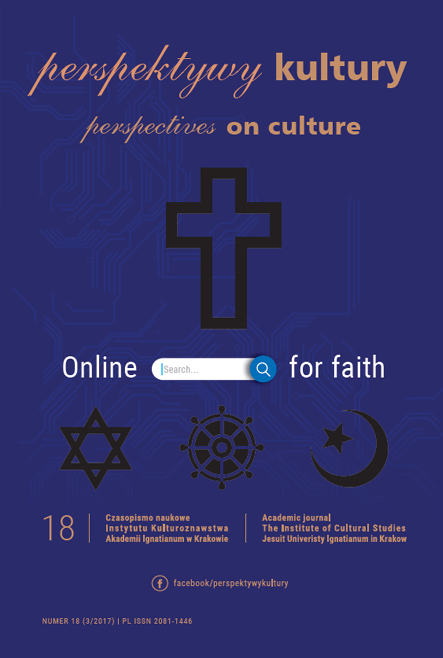World of Warcraft as a New Form of Religion?
Abstract
In the paper, the author is studying religious phenomena in the vide- ogame called World of Warcraft (WoW) and compares them with tra- ditional religions such as Christian religion and Buddhism. According to author, religious phenomena exist in WoW in the form of myths, rituals and in the creation of communities. This religious phenomena are not completely fictional, because the players are influenced by the virtual (there are cognitive changes), and then we have to accept some degree of the reality here. The author claims that WoW can partially saturate spiritual needs of the contemporary hypermodern man. How- ever, the author states that it cannot replace traditional religion since it lacks its main part – salvation of the man in Christianity (or freeing in Buddhism), which is achieved through self-knowledge, eliminat- ing bad inclinations, prayers or meditation. Traditional religions have a basic structure of religion expressed by the matrix “life – death – res- urrection” which is directly connected with the human body. Human body still constitutes an important part for salvation (or freedom), in- troducing thus a boundary between the real and virtual. According to author, WoW is similar to theatre in the Ancient Greece, the game of WoW can have cathartic effects on the player, but cannot replace tra- ditional religion.
References
BERGSON, H. 1970. Filozofické eseje. Bratislava.
ELIADE, M. 1997. Dejiny náboženských predstáv a ideí II. Od Gautamu Budd- hu po vííazstvokresíanstva. Bratislava.
ELIADE, M.. 1999. Jóga. Nesmrtelnost a svoboda. Praha.
GÁLIK, S. 2015. “Cyber-spirituality as a new form of religion?”. European Journal of Science and Theology 11/6: 5-14.
GÁLIK, S., CENKÁ, R. 2013. “Twilight of Christianity in Tele-view of the World: from Homo religious to Homo videns”. European Journal of Science and Theology 9/5: 232.
GERACI, R.M. 2014. Virtually Sacred. Myth and Meaning in World of Warcraft and Second Life. New York.
GRIEVE, G.P., CAMPBELL, H.A. 2014. Studying Religion in Digital Ga- ming. A Critical Review of an Emerging Field. In Simone Heidbrink, To- bias Knoll (eds.): Religion in Digital Games. Multiperspective & Interdi- sciplinary Approaches. Online – Heidelberg Journal of Religions on the Internet 5: 51-67.
KOMOROVSKÝ, J. 2000. Religionistika. Veda o náboženstvách sveta a jej po- mocné disciplíny. Bratislava
TUCKETT, J.D.F., ROBERTSON, DAVID G.2014. Locating the Locus of
Study on „Religion“ in Video Games. In Simone Heidbrink, Tobias Knoll (eds.): Religion in Digital Games. Multiperspective & Interdisciplinary Approaches. Online – Heidelberg Journal of Religions on the Internet 5: 86-107.
VALLIKATT, J. 2014. Virtually Religious: Myth, Ritual and Community in World of Warcraft. Melbourne.
WIEMKER, M., WYSOCKI, J. 2014. „When people pray, a god is born... This god is you!“ Introduction to Religion and God in Digital Games. In Simone Heidbrink, Tobias Knoll (eds.): Religion in Digital Games. Multiperspecti- ve & Interdisciplinary Approaches. Online –Heidelberg Journal of Religions on the Internet 5: 207.
Copyright (c) 2017 Jesuit University Ignatianum in Krakow

This work is licensed under a Creative Commons Attribution-NoDerivatives 4.0 International License.
Autor, zgłaszając swój artykuł, wyraża zgodę na korzystanie przez Wydawnictwo Uniwersystet Ignatianum z utworu na następujących polach eksploatacji:
- utrwalania utworu w formie papierowej, a także na nośniku cyfrowym lub magnetycznym;
- zwielokrotnienia utworu dowolną techniką, bez ograniczenia ilości wydań i liczby egzemplarzy;
- rozpowszechniania utworu i jego zwielokrotnionych egzemplarzy na jakimkolwiek nośniku, w tym wprowadzenia do obrotu, sprzedaży, użyczenia, najmu;
- wprowadzenia utworu do pamięci komputera;
- rozpowszechniania utworu w sieciach informatycznych, w tym w sieci Internet;
- publicznego wykonania, wystawienia, wyświetlenia, odtworzenia oraz nadawania i reemitowania, a także publicznego udostępniania utworu w taki sposób, aby każdy mógł mieć do niego dostęp w miejscu i czasie przez siebie wybranym.
Wydawca zobowiązuje się szanować osobiste prawa autorskie do utworu.





